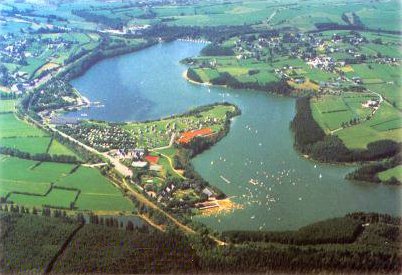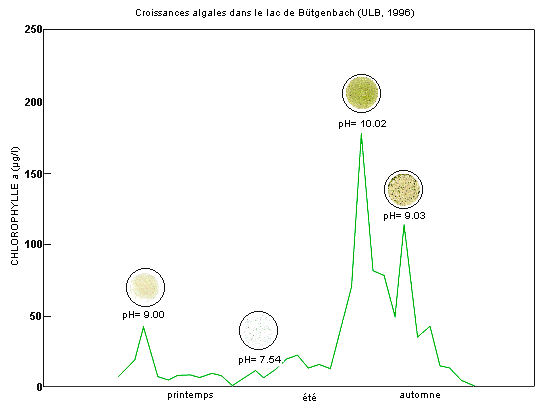Study of the eutrophication status and ecology of Lake Butgenbach (Eastern Belgium).

Lake Butgenbach (see figure) was built in the most Eastern part of Belgium for flood control purposes and for
limited hydro-electric production. The contributing watershed (5000-10000 inhabitants throughout year) primarily
corresponds to agricultural land (fertilized grassland and forest) although lake surroundings host a number of
recreational facilities very popular in the nice season. The lake has been known as suffering from eutrophication
for some years and phosphorus inputs of domestical, industrial and agricultural origin are obviously a key factor
in algal growth development.
Three consecutive periods emerge from the intensive monitoring surveillance of the water composition in 1996
(see figure): a moderate algal growth (40 mg chl.a/l) in early spring,
a clearwater episode (<20mg chl.a/l)
lasting about twelve weeks, followed by a strong blue-green algae bloom
(chl.a > 150 mg/l) in begin autumn.
These observations are correlated by others. In the epilimnion CO2 partial pressure markedly fluctuates during
the whole period and reaches a very low value (min pCO2=7.10-7 atm) at the highest of the algal bloom.
Although total inorganic carbon stays at rather limited amounts, the C/N/P ratios (2500/2000/1) shows that
phosphorus is the potential limiting factor controlling algal growth.

In the aim of better understanding the cycling of phosphorus and its role in the observed eutrophication process,
the various chemical forms of phosphorus have been determined in the lake and its tributaries. Three dissolved
phosphorus species: dissolved reactive phosphorus (DRP), dissolved polyphosphate (Poly.), dissolved organic
phosphorus (DOP) and two particulate fractions: organic (POP) and inorganic (PIP) were measured between march
1998 and September 1998. Samples were taken in the two incoming rivers, as well as in the epilimnion, the
hypolimnion and just above the sediment of the lake.
Except for the water in close contact with the sediment, total phosphorus levels are higher in the rivers
than in lake waters. The total dissolved fraction represents more than 70 % of the total P. DRP represents
in the rivers more than 50% of the total P. This highlights the domestical and industrial origin of the phosphorus
in these rivers.
In the epilimnion of the lake, DRP is metabolized by the phytoplancton and levels are very low: they never
exceed 2 mgP/l. DOP is generaly not measured in water quality study.
Though, it equals nearly 10 mg P/l in the
epilimnion and could be (with the action of phosphatases) a source of potentially available phosphorus for
phytoplankton growth. The increase of the particulate fraction (TPP) of phosphorus from the surface to the
bottom is the manifestation of the sedimentation process.
Conclusion
Routine phosphorus surveillance parameters (usually restricted to DRP and total P) do not necessarily provide
the right information about the dynamics of phosphorus within the limnic environment. It is apparent that DRP
is very rapidly recycled, this being illustrated by the intensity of primary production at such low DRP ambient levels.
The concentrations of DOP, which were shown to vary significantly with time of the year, could maybe constitute a pool
of bio-available phosphorus for algal growth through the action of phosphatases.
The remineralization processes are dominant in the hypolimnion. This part of the water column is influenced in
summer by the intersticial water of the sediment highly concentrated in dissolved phosphorus. Due to the
phosphorus levels in the rivers (50-300 mg P/l) and the small
volume of such a lake, the annual surfacic load (3.3-6.6 gP/m2.an) is too high to prevent
excessive algal blooms in the lake. To improve the water quality of the lake, phosphorus concentration
in the tributaries should be drastically lowered.
Contact for further information: mikeverb@ulb.ac.be






